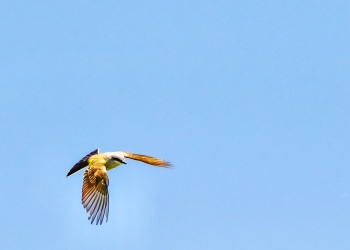- Tyrannus verticalis
Identification
A large flycatcher of 19·5–24·1 cm 7.5-9½ in); wingspan 15-16.5 in.
The head and back are pale grey, the neck is white, and the underparts are yellow. This bird has white outer tail feathers and a small red stripe that is seldom seen on the top of the head.
Distribution
Breeds in western North America from southern British Columbia east to Minnesota, western Wisconsin, Iowa, Kansas south to Texas and the Mexican border. Winters in southern Mexico south to Costa Rica; also a few winter in southern Florida. Rare but regular vagrant throughout eastern North America north to Newfoundland. Accidental vagrant north of range to Alaska.
Taxonomy
This is a monotypic species[1].
Habitat
Open country with trees, shrubs, or tall man-made structures. Habitats include grassland, desert shrub, pasture, savanna, and urban areas.
Behaviour
Breeding
They construct a sturdy open cup nest of grass stems, rootlets, fine twigs, bark and plant fibres, lined with soft material such as wool, cotton, hair, feathers, and cloth It is placed in trees or on man-made structures, such as utility poles and fence posts. The clutch consists of 2-7 eggs which are creamy white with heavy dark spots, concentrated around large end.
They time their breeding effort to when there is an abundance of insects.
Diet
Insects and occasionally berries. Perches upright on tall weeds, exposed branches, or wires before sweeping forward to catch insects in mid-air. They do not eat from most seed feeders.
Vocalisation
A loud sharp kit Also chatters much like the Scissor-tailed Flycatcher.
References
- Clements, J. F., T. S. Schulenberg, M. J. Iliff, S. M. Billerman, T. A. Fredericks, B. L. Sullivan, and C. L. Wood. 2019. The eBird/Clements Checklist of Birds of the World: v2019. Downloaded from http://www.birds.cornell.edu/clementschecklist/download/
- Handbook of the Birds of the World Alive (retrieved July 2018)
- BirdForum Member observations
Recommended Citation
- BirdForum Opus contributors. (2024) Western Kingbird. In: BirdForum, the forum for wild birds and birding. Retrieved 29 April 2024 from https://www.birdforum.net/opus/Western_Kingbird
=External Links
Search the Gallery using the scientific name:
Search the Gallery using the scientific name:
GSearch checked for 2020 platform.





